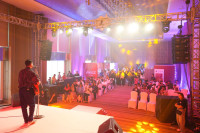Culture & Lifestyle
The ethos behind the Valley’s mural culture
The government’s decision to erase a mural at Ratnapark in June has once again fostered discussions on the role these artworks play in society.
Srizu Bajracharya
Ever since the Covid-19 pandemic gripped the country last year, essential workers from health care professionals to police and security officials have played an instrumental role in ensuring people access to important services.
Keeping their sacrifices and contribution in mind, four artists decided to make a colourful tribute mural on an overhead pedestrian crossing wall at Ratnapark. For those who passed by the mural, the artwork reminded of the crucial role frontline workers play as the nation deals with the pandemic.
But the mural had a short lifespan. Two weeks after the artwork was completed, officials from Kathmandu Metropolitan City erased the mural. This act didn't go down well with the general public, and many took to social media to protest the government's decision to remove the mural.
Today, about a month after the erasure of the mural, Sangay Thinley Lama, one of the artists behind the mural, says he harbours no ill feelings towards those responsible for taking down the mural.
Sitting at his tattoo inn in Boudha, Lama says the outpouring of public support has made him reaffirm his faith and appreciate the role art plays in encouraging discourses. "That mural was a turning point for me. It made me realise the role art plays in moving people. So many people reached out to me saying how disheartened they were to see the work erased. That incident has stirred my spirit as an artist. Now, I think about how there is so much to do," says Lama. "It would have been nice had the mural stayed there for a little longer, but that's okay. The fate of public murals is after all temporary."
Lama's peace with the incident comes with the realisation that the event managed to do something for the city's mural art scene that has remained under the radar for some time. The removal of the mural catalysed meaningful conversations on murals and their evolving role in society.
In the last one decade or so, the city's modern mural scene has ebbed and flowed. There was a time when it was common to see new murals pop up quietly in different parts of the city and become part of everyday life as though they had always been there.
But it's not the same case anymore.
Today, only a handful of artists are consistently pursuing this artform passionately and tactfully.
.JPG)
While the mural culture might seem a recent phenomenon to many, Madan Chitrakar, a veteran art writer and critic, says that Nepal has a long and rich mural history, with the art form dating back centuries.
In his book 'Nepali Art Thoughts & Musings', Chitrakar mentions that for centuries artists made murals of deities in temples and vihars.
Until a decade ago, most major businesses made murals to advertise their products. This practice has now almost been replaced by hoarding boards.
This, artists say, clearly shows that murals are not alien to the local tradition and are interwoven with the local tradition and culture.
The birth of what is now commonly considered murals happened in 2011.
"When works of some international street artists started popping up in walls of the Valley, it was refreshing and intriguing for art students like us," says Shraddha Shrestha, an independent visual artist and illustrator. Shrestha was initially part of ArtLab, which was active in the early street art scene of Kathmandu. The group consisted of artists like Sadhu-X, Romel Bhattarai, Anish Bajracharya, Shreejan Shrestha and Kiran Maharjan, aka H11235.
Inspired by art's ability to change the look and feel of places, Shrestha and her group and other young art graduates of the time started painting on public walls. They were making characters, colourful graphic patterns and imageries while also tagging their names to the walls. "The how-tos of making murals was not something that we were taught in our art schools. It was something our generation observed in Kathmandu's walls," she says. "The public walls in Jamal, Ratnapark, Thapathali were full of political messages. And in 2011, when we began creating murals on these walls, there were not many objections. People were rather curious about what we were trying to do."
At that time, graffiti writings and murals were already visible in the alleys of Thamel and Pokhara, in areas where there were more tourists.
Young artists like Shrestha were influenced by the works of Bruno Levy, a French artist. He painted big feet and eccentric characters along the walls of Ratnapark, Thapathali and various other places in Kathmandu. Works of French artist Invader, who in 2008 went around in Kathmandu leaving tiles of 1978 arcade game Space Invaders, also encouraged many artists to get into the art form.
.JPG)
A Kathmandu-based organisation that played an important role in promoting murals is Sattya Media Arts Collective, a non-profit organisation. In 2012, the organisation started a year-long project titled Kolor Kathmandu, the brainchild of Yuki Poudyal, who was at the time associated with the organisation. By the end of the project in 2013, Kolor Kathmandu had given the city about 77 public murals.
"When I was in Philadelphia, US, I saw the city's artists use murals to bring together communities and portray sentiments of the public. So, when I joined Sattya, I wanted to work on a project that could do something similar here. But I never imagined that the project would go on to set a culture and snowball into something so big that it would be visible to all. And I hadn't imagined that our project would encourage people to see art in such an interactive way," said Poudyal.
By 2013, with murals becoming a common sight across the Valley, businesses started commissioning artists to create murals as interior design. Many artists were also collaborating with social organisations that were using the art form to raise awareness of social and health issues.
Later, many other art projects and festivals also steered the modern mural culture forward.
But in the last few years, many artists say that the Valley has seen a steady decline in the number of new murals in public spaces.
"When we first started making murals, the majority of the artists were using their own funds to create the artworks. But since then, many of us have moved on to other kinds of works," says Kiran Maharjan, a visual artist and muralist. "But another reason I think for the decline in the number of new murals is that over the years, public walls have become increasingly inaccessible."
.JPG)
Around the world, in cities where public mural culture is flourishing, artists have received support from the government. But such support, say artists, has been missing in the Valley.
"Every time the support has come, it has come from the general people or the local community. The government is not keen on having murals on the public walls because it hasn't understood how artworks can impact the experience of the city," says Maharjan.
Kailash Shrestha, visual artist and founder of Artudio Centre for Contemporary Visual Arts, remembers the last time he visited Kathmandu Metropolitan City to seek permission to paint public walls with the theme 'We make the nation'. It was in 2011, and he wanted the artwork to make a socio-political commentary by involving the youth. His collective later went on to create the artwork on the walls of Hotel Himalaya in Kupondole, Lalitpur.
"The officials denied my request without even giving it much thought. They said the state does not allow such practice. The government's lack of understanding of murals was recently demonstrated when it wiped out a meaningful public mural at Ratnapark without acknowledging what it means for the people. This shows how indifferent the government is," says Shrestha.
"When the state refuses to appreciate and provide platforms to art, literature and songs that can communicate and address society's many issues, such a state is bound to fail," he further adds.

And over the years, the Valley's authorities have intensified their intolerance towards murals. "It is riskier to make social-commentary artworks in public now because anything can happen. The authorities can come and take you away. It's not a space that offers freedom like before. If you go ahead and do it anyway, you have to face the consequences, and not all artists have the luxury to do it," says Sadhu-X, who is one of the first artists to get into street art and mural culture and is also the co-founder of Kaalo.101.
The government's intolerance and indifference towards murals have meant that artists including and organisations like Artudio and Kaalo.101, who were once at the forefront of the Valley' modern mural culture, have now shifted to working with communities, especially inside the alleys and roadways of Patan. These communities, they say, are more open to the idea of having artworks that foster conversations. The photo festival 'Photo Kathmandu' and art festival 'Kathmandu Triennale' have both played with murals and stencils inside the inner neighbourhoods of the Valley. Working with communities and businesses has been easier and more fulfilling for artists than working on the public walls, where they feel less safe.
"India's street art scene came much later than in Nepal, but yet they have done so much good work and outdone us in many ways. And their strength has been that the local governments have been involved with colouring the areas with the artists themselves," says Sadhu-X.
But as the culture of modern mural-making turns a decade old, some artists are hopeful that murals will once again be accepted like it once was and the scene will see more things happening in the years to come.
"The outcry that ensued after the government erased the Ratnapark mural made us all aware of the power of the art form," says Lama, who is now preparing to make another mural on the theme of pandemic resilience. "What we now need is more energy from artists and more people to continue making murals. Because the more we make murals, the more acceptance it will get. We need to go out there and colour the world more, and soon there will come a time when making murals will no longer mean standing against something."
(Anup Ojha contributed reporting.)




 9.12°C Kathmandu
9.12°C Kathmandu













%20(1).jpg&w=300&height=200)

